Geeta IB1*, Anaida Clara Alex2, Arvind B3
1Professor, Department of Conservative Dentistry and Endodontics, Rajarajeswari Dental College and Hospital, Bengaluru, India
2Department of Conservative Dentistry and Endodontics, Rajarajeswari Dental College and Hospital, Bengaluru, India
3Post Graduate Student, Department of Conservative Dentistry and Endodontics, Rajarajeswari Dental College and Hospital, Bengaluru, India
Correspondence author: Geeta IB, Professor, Department of Conservative Dentistry and Endodontics, Rajarajeswari Dental College and Hospital, Bengaluru, India; E-mail: [email protected]
Published Date: 24-12-2023
Copyright© 2023 by Geeta IB, et al. All rights reserved. This is an open access article distributed under the terms of the Creative Commons Attribution License, which permits unrestricted use, distribution, and reproduction in any medium, provided the original author and source are credited.
Abstract
Tooth jewellery is an emerging trend in cosmetic dentistry, offering a novel and non-invasive means of personalizing one’s smile. This innovative practice involves the application of small, decorative gems or metals to the surface of teeth, often using safe dental adhesives. While primarily a cosmetic enhancement, tooth jewellery has gained popularity due to its versatility and temporary nature, allowing individuals to experiment with different styles and remove them at will.
This review article explores the burgeoning field of tooth jewellery within dentistry, highlighting its aesthetic appeal and the minimal impact it has on oral health. It delves into the variety of materials and designs available, emphasizing the importance of professional application to ensure safety and durability. Furthermore, it addresses the cultural and societal influences behind this trend, reflecting how individuals increasingly view their smiles as canvases for self-expression.
Tooth jewellery represents an intriguing intersection of art and dentistry, presenting a unique option for those seeking to add a touch of glamour to their smiles. While not without its considerations, the practice showcases dentistry’s evolving role in offering innovative solutions that go beyond oral health, aligning with the broader concept of enhancing overall well-being through self-expression and confidence.
Keywords: Cosmetic; Dentistry; Fashion; Jewellery
Introduction
Aesthetics has become an important aspect of dentistry over the past few years and has led to the development of new materials and techniques. Today, people are becoming increasingly selfconscious about their appearance and smile [1]. With the introduction of cosmetic dental treatments like porcelain veneering, composite veneering, bleaching and placement of tooth jewellery, patients smile can be made more pleasing, appealing and aesthetic. Among these cosmetic dental treatments bleaching and veneering procedures which are invasive are indicated for patients with discolored teeth, spacing between teeth and mild irregular teeth, whereas oral tooth jewellery is for all patients who wants a dazzling smile (Fig. 1) [2,3].
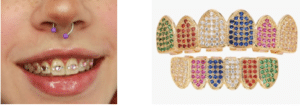
Figure 1: Oral tooth jewellery.
Historical Review
Tooth jewellery is not come in trend recently, it has been introduced decade back when most skillful and artistic work was done by craftsman of the maya. In the 9th century Mayan culture where teeth were embellished with jade and turquoise, but current trends in dentistry include the addition of gold, jewels or crowns that appear similar to stainless steel crowns, previously considered nonaesthetic. Mayans were accomplished smelters and forgers of gold, silver and bronze. They were skilled in the fabrication and placement of beautifully carved stone inlays in precisely prepared cavities in the front teeth [4,5].
Later on, the glittering grills of some hip-hop stars were not exactly unprecedented. But, according to the new study, this concept of Native Americans added bling to their teeth as far back as 2500 years ago. These days women take more interest in making their personality so beautiful and attractive as compared to men. Like different kinds of makeup, dresses they wear, the food they eat in restaurants, the kind of luxurious and rich lifestyle they live, even they add dental jewellery to it in order to show how glamorous they live their life and how their standards are so high [6].
According to a recent analysis of thousands of teeth examined from collections in Mexico’s national institute of anthropology and history, it was shown that ancient people of southern North America went to the dentists to beautify their choppers with notches, grooves and semiprecious gems. They began to be worn by hip hop artists in the early 1980’s and upgraded during the 90s in New York City, but they became more widely popular during the mid-2000s due to the rise of dirty south rap and the more mainstream pop culture status hip hop attained. Even now in 21st century, people use dental jewellery while going to parties, ceremonies or any event, people have added cosmetic dentistry to their life in order to enhance their living style [7].
Metallurgy
Tooth jewellery, a cosmetic dental procedure where a diamond or a stone is attached to the teeth is gaining utmost importance with increasing awareness among people. Tooth Gems and Dazzlers are the different types of tooth jewel available in the market. Tooth Gems include Skyce and Sapphire crystals, both are high quality tooth jewels, but Skyce put an extra sparkle into every smile with its clear crystals whereas Sapphire possesses white or blue crystals. Skyce are clear and sapphire white or blue crystals. Brilliance tooth jewelry is available in 3 different colors crystal clear, sapphire blue, ruby red and is of two sizes – 1.8 mm, 2.6 mm [8].
Dazzlers are the tooth jewels which are specially designed to be bonded to the tooth with its patented backside like an orthothontic bracket which makes them lasts longer. Twinkles are pure gold with precious stones like diamond, sapphires and rubies. Rainbow crystals are the least expensive version of tooth jewelry. They’re ideally for short term attachment, to try the new service in your practice or for the customer with a smaller budget rainbow crystals are available in 10 different colors and two sizes (1.8 mm and 2.5 mm) [9].
Dental crystals are glass mounted on a thin foil of aluminum to establish an attractive smile although the bonding here is not as durable as in tooth gems, but can easily last for six months. A variety of shapes are available in the market like diamond, star, triangle, droplet, heart and round shape (Fig. 2) [10].

Figure 2: Dental crystal.
Twinkles are pure gold and precious stones like diamonds, sapphires and rubies in different shapes like diamond, star, triangle, heart shape, drop, navette and round shapes. Apart from the above-mentioned crystals, metals like gold, titanium, platinum etc can be also be incorporated (Fig. 3,4) [10].

Figure 3: Intraoral analogous designs.
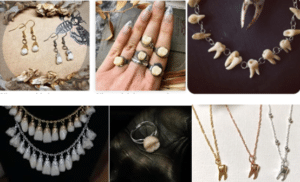
Figure 4: Extraoral analogos designs.
Procedure and Bonding Protocol:
The tooth is cleaned with a fluoride-free polishing paste. Completely dry and isolate the tooth.
Tooth is etched with 37% orthophosphoric acid for about 20-30 sec to increase the surface area for bonding. Rinse surface thoroughly with water and blow dry for 10 sec (Fig. 5).

Figure 5: Acid etching with 37% orthophosphoric acid for 20-30 sec.
Apply a light-curing bonding agent. Leave it on for a maximum of 20 seconds, distribute bonding through air blowing. Then light-cure for 20 sec (Fig. 6).
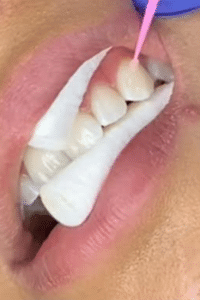
Figure 6: Applying a light curing bonding agent.
Apply a small amount of flow composite to the surface of the tooth. Use a jewel handler to easily pick up the jewel. Press it into the center of the composite. (The composite must ooze on the sides so it is encircled by the composite, ensuring macro mechanical retention, but make certain the jewel is in contact with the enamel) (Fig. 7).
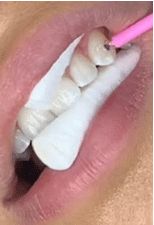
Figure 7: Placement of the tooth jewel.
Adjust the jewel while letting the patient check the desired positioning in the mirror. Take the light-curing lamp and start curing the composite from the top for about 60 seconds. Light cure from the sides for a few seconds and also cure the composite from the back of the tooth for another 60 seconds making sure the composite sets evenly. Total curing time is approximately 180 seconds. The total time for jewel to set into the composite is 20 sec. Do not touch the jewel with your fingers once it’s removed from the case. To guarantee maximum adhesiveness, it is essential to avoid skin contact with the special coating on the backside of the jewel. It takes about 4 minutes to safely affix the jewel (Fig. 8).
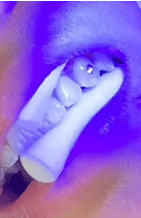
Figure 8: Placement of the tooth jewel.
Removing the Tooth Jewel
The jewel is removed in the same way as an orthodontic bracket and the enamel will not be harmed. After removal of the gem, the tooth needs to be polished, which takes away any remaining bonding materials. Use a scaler or a rubber polisher when removing the stone. In case of leftover bonding or composite on the tooth, simply remove it by using a polishing tool. It is recommended to treat the tooth with fluoride, so remineralization and stabilization of the enamel is provided [3,4].
Complications Associated with Tooth Jewellery
Complications related to tooth jewellery have been discussed below in order to aware the people because now-a-days most of the people are recommended to use tooth jewellery to enhance their aesthetics and to improve the self-esteem and self-confidence as well, but there are certain complications associated and is highly recommended only in those patients who are having good oral hygiene maintenance [11].
The Reason Behind are Many, Some of Them are Illustrated Below
Aspiration, allergy or chronic injury to adjacent teeth/mucosa, including tooth fracture. Attachment area of the tooth jewellery is highly prone for plaque accumulation, the area has to be clean as possible. It should not be advised to the patient having high caries. Gingival inflammation, diminished articulation and metal allergy are also the some of the major complications associated with tooth jewellery. Sometimes movable jewellery can cause abrasion of teeth. Fixed teeth grills are very difficult to be kept clean and hence a removable type should be chosen (Fig. 9) [12,13].

Figure 9: Tooth jewellery cleaning and plaque accumulation.
Few mild clinical symptoms can be expected with tooth jewellery placement which are reversible with removal of the jewel and appropriate management of symptoms.
Conclusion
Patients want a sparkling smile in order to improve their beauty even more and the dentists want their teeth to be healthy. Cosmetic dentists are committed in maintaining the health of teeth at all costs. Unlike other, tooth jewellery, there is no pain, infection, no drilling and no damage to tooth, easily removable and at the same time add more attractiveness and sparkle to the smile, makes them more user friendly.
Conflict of Interest
The authors have no conflict of interest to declare.
References
- Bhatia S, Arora V, Gupta N, Gupta P, Bansal M, Thakar S. Tooth jewellery-its knowledge and practice among dentists in Tricity, India. J Clin DiagnRes: JCDR. 2016;10(3):ZC32.
- Bhatia S, Gupta N, Gupta D, Arora V, Mehta N. Tooth jewellery: fashion and dentistry go hand in hand. Ind J Dent Adv. 2015;7(4):263-7.
- Sharma M, Sharma RK, Upadhyay M, Mishra P. Making a fashion statement with dental jewellery. IJ Pre Clin Dent Res. 2014;1(3):53-5.
- Anandkumar GP. Tooth jewellery: a simple way to add sparkle to your smile Indian J Dental Advancements. 2010:2
- Peter T, Titus S, Francis G, Alani M, George A. Ornamental dentistry-An overview J Evol Med Dent Sci. 2013;2:666-7.
- Vuković AA, Bajsman A, Zukić S, Šečić S. Cosmetic dentistry in ancient time – Short review. Bull Int Assoc Paleodont. 2009;3:9-13.
- Jones A. Dental transfigurements in Borneo. Br Dent J. 2001;191:98-102.
- Bachani J, Dhruti P, Patel A, Darmina J. Fashion trends in dentistry. J Res Med Dent Sci. 2014;2:102.
- Gandhi SR, Gandhi R, Minase D. Passion of fashion–oral jewellery. J Interdiscip Dent Sci. 2020;9(1):1-6.
- Sanghavi SM, Chestnutt IG. Tooth decorations and modifications: current trends and clinical implications. Dent Update. 2016;43:313-8.
- Yadav P, Mohapatra AK, Jain A. Oral piercing/ART-fashion or risk. J Adv Med Dent Sci Res. 2014;2:100-3.
- Pinchi V, Barbieri P, Pradella F, Focardi M, Bartolini V, Norelli GA. Dental ritual mutilations and forensic odontologist practice: A review of the literature. Acta Stomatol Croat. 2015;49:3-13.
- Rangelov S, Mariana D. Dental grillz – critical analysis and patient opinions. J IMAB Annu Proc (Sci Pap). 2022;28:4366-70.
Article Type
Review Article
Publication History
Received Date: 25-11-2023
Accepted Date: 17-12-2023
Published Date: 24-12-2023
Copyright© 2023 by Geeta IB, et al. All rights reserved. This is an open access article distributed under the terms of the Creative Commons Attribution License, which permits unrestricted use, distribution, and reproduction in any medium, provided the original author and source are credited.
Citation: Geeta IB, et al. Tooth Jewellery: Sparkle with Aurora of Dental Cosmos: An Overview. J Dental Health Oral Res. 2023;4(3):1-6.

Figure 1: Oral tooth jewellery.

Figure 2: Dental crystal.

Figure 3: Intraoral analogous designs.

Figure 4: Extraoral analogos designs.

Figure 5: Acid etching with 37% orthophosphoric acid for 20-30 sec.

Figure 6: Applying a light curing bonding agent.

Figure 7: Placement of the tooth jewel.

Figure 8: Placement of the tooth jewel.

Figure 9: Tooth jewellery cleaning and plaque accumulation.


